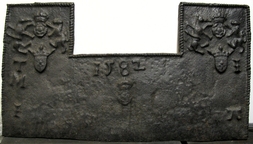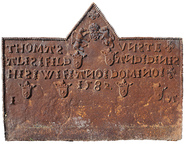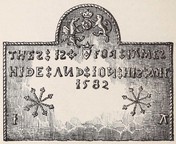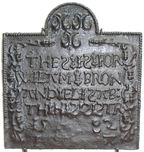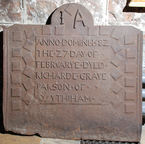-
107
Description: Rectangle with two similar rectangular extensions at top extremities; rope edging (top and sides); on top extensions, two stamps of a dragon and lion supporting a rose and crown, each with a crowned shield bearing a fleur de lys below; central date with rose and crown below; initials TM vertically placed inside middle left edge, initial I middle right; initials I and A, respectively, at lower left and right.
Notes: The initials, TM and I, may relate to a married couple, the first two letters to their first names and the last to their surname; the initials IA are likely to be of the founder as they appear in the same arrangement on other firebacks. The unusual shape would probably have been determined by the structure of the hearth for which it was made; the rose and crown and supporters stamp can also be seen on a large fireback, dated 1593, formerly at Baynard's Park, Surrey (no. 200); the date and IA stamps can be seen, in identical form, on a fireback in the Victoria & Albert Museum, and on two other firebacks, suggesting a common source for all of these firebacks.
Inscription: TM 1582 I / I A
- Decoration tags:
- rectangular with two arches (shape)
- rope (edging)
- carved stamps
- individual letters
- individual numbers
- heraldic
- royal
- text
Manufactured: in 1582 possibly at Pounsley Furnace, Framfield in the Weald area of England.
Current location: Haslemere Educational Museum, Haslemere, Surrey, England.
Museum number: 8582 (part of the Haslemere Educational Museum museum group)
Citation: Anon., 1929, 'An interesting fireback', Sussex Notes and Queries, 2, 8 , p. 242.
- Attached to series:
- 1582 IA series
- Pounsley series
-
472
Description: Rectangular with central triangular arch; twisted rope edging (top and sides); in arch, on top, a small cross formed of fleurs-de-lys above a rose and crown with dragon and lion supporters above two crowned shields each bearing a small fleur-de-lys; text across top half, a small cross formed of fleurs-de-lys ending the first and third lines, the top two lines split by the crowned shields, each word separated by two opposed fleurs; below the text, four crowned shields each with a fleur-de-lys, the date between the middle two; lower left, 'I'; lower right, 'A'.
Notes: The inscription can be interpreted as Thomas Anstie alias Field and Denise his wife (etc.), the surname Anstie alias Field being known in the 16th century in central Sussex. A Thomas Anstye married Denys Joyner at Wivelsfield, Sussex on 5th June 1564; illustrated in Lower, 1849 p. 189 with some errors in transcription of the inscription; formerly at 'Misfield' (Miswell), Worth, Sussex. One of a small series of distinctive firebacks cast in 1582, most with inscriptions dedicated to pairs of individuals; the initials IA are likely to be of the founder as they appear in the same arrangement on the other firebacks; the rose and crown and supporters stamp can also be seen on a large fireback, dated 1593, formerly at Baynard's Park, Surrey (no. 200).
Inscription: THOMAS VNSTE / ALIS : FILD AND DINIS / HIS : WIF: ANO : DOMINO: / 1582 / I A
- Decoration tags:
- rectangular with triangular arch (shape)
- rope (edging)
- carved stamps
- individual letters
- individual numbers
- heraldic
- text
Manufactured: in 1582 possibly at Pounsley Furnace, Framfield in the Weald area of England.
Current location: Gwesty Seren Hotel (formerly Bryn Llewellyn), Allt Goch, Llan Ffestiniog, Gwynedd, Wales.
- Attached to series:
- Pounsley series
- 1582 IA series
-
473
Description: Arched rectangular shape; twisted rope edging (top and sides); in arch; rose and crown with dragon and lion supporters, above a fleur cross and a crowned shield bearing a small fleur-de-lys; text across top half, each word separated by two fleur terminals; lower left and right, twice repeated eight-pointed star design formed of twisted rope with fleur-de-lys terminals; bottom left, ‘I’; bottom right, ‘A’.
Notes: A James Hide married Joan Blackefane at Horley, Surrey on 11th October 1579; illustrated in Lower, 1849 p. 217, when it was at Sutton Hurst, Barcombe, Sussex (still there in 1893, house since demolished). One of a small series of distinctive firebacks cast in 1582, most with inscriptions dedicated to pairs of individuals; the initials IA may be of the founder as they appear in the same arrangement on other firebacks; the rose and crown and supporters stamp can also be seen on a large fireback, dated 1593, formerly at Baynard's Park, Surrey (no. 200).
Inscription: THES : IS FOR IAMES : / HIDE : AND : ION : HIS : WIF [W inverted] / 1582 / I A
- Decoration tags:
- rectangular with round arch (shape)
- rope (edging)
- carved stamps
- individual letters
- individual numbers
- heraldic
- text
- objects
Manufactured: in 1582 possibly at Pounsley Furnace, Framfield in the Weald area of England.
Current location: not known.
- Attached to series:
- Pounsley series
- 1582 IA series
- Fleur rope terminal series
-
744
Description: Arched rectangular shape; twisted rope edging (top and sides only); three water bougets (leather water containers) at top; knotted cord and tassel decoration on each side; centred inscription on six lines with ‘S’ reversed, bar across top of ‘A’ and letters individually placed and separated by small, opposed fleurs-de-lys.
Notes: The approximately mirrored cord decoration appears to have been affixed to shaped boards. The Wealden origin of this fireback suggests possible connections with the Roos, or de Ros, family, who owned property in Easebourne, or the Meeres family of Glynleigh, near Hailsham, the arms of both families incorporating water bougets. A connection, previously proposed by the Victoria and Albert Museum, with the Ross family of Helmsley, Yorkshire, is improbable. One of a small series of distinctive firebacks cast in 1582, most with inscriptions dedicated to pairs of individuals; the initials IA may be of the founder as they appear in the same arrangement on other firebacks. Part of the bequest to the Victoria and Albert Museum by Lieut. Colonel G. B. Croft-Lyons in 1926.
Inscription: THES:IS:FOR / WILAM:BRON / AND:ELISAB: / TH:HIS:SISTR / 15 82 / I A
- Decoration tags:
- rectangular with round arch (shape)
- rope (edging)
- simple stamps
- carved stamps
- individual letters
- individual numbers
- heraldic
- text
- objects
Manufactured: in 1582 possibly at Pounsley Furnace, Framfield in the Weald area of England.
Current location: Victoria & Albert Museum, Cromwell Road, Kensington & Chelsea, Greater London, England.
Museum number: M.977-1926 (part of the Victoria & Albert Museum museum group)
- Attached to series:
- Pounsley series
- 1582 IA series
-
798
Description: Arched rectangular shape with canted top corners; astragal-and-fillet and cavetto moulded strip on each side, angled at top; raised central square panel bearing main inscription in sans-serif characters justified to left (2s formed like Zs); irregular arrangement of small ‘serrated’ square stamps repeated 29 times in two vertical groups of 12 on each side of the inscription panel (6 on the outside, side to side, 6 on the inside, roughly corner to corner); 2 squares, side to side, below each side of the arch, above the inscription panel; 1 square at top of arch between non-matching initials.
Notes: The inscription is the same as on the iron plate above the grave of Richard Gray in Withyham church; another fireback, said to have the same inscription, was formerly at Wolvesey Palace, Winchester, and later in Winchester Museum, but is now missing; the moulding strips are likely to have been derived from furniture. Frances Ashbie and Richard Graye's godson, Richard, the son of William Ashbie, were among the beneficiaries of Richard Graye's will and the initials, IA, on the fireback may relate to another member of that family. The fireback was noted at Sompting, near Lancing, West Sussex, in the 1820s.
Inscription: I A / ANNO·DOMINI·1582 / THE·27·DAY·OF·· / FEBRVARYE·DYED· / RICHARDE·GRAYE / PARSON·OF· · / WYTHIHAM·
- Decoration tags:
- rectangular with round arch (shape)
- complex, furniture-derived (edging)
- carved stamps
- carved pattern panels
- individual letters
- text
Manufactured: in 1582 probably at Hamsell Furnace, Rotherfield in the Weald area of England.
Current location: St Michael's church, Withyham, East Sussex, England.
Citation: Arnold, F., 1871, 'Withyham Monumental Slab', Sussex Archaeological Collections, 23, pp. 320-1.
- Attached to series:
- Richard Graye inscription series
- Epitaph firebacks
